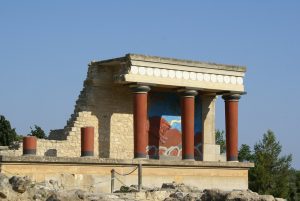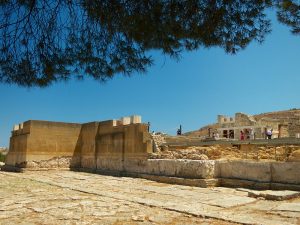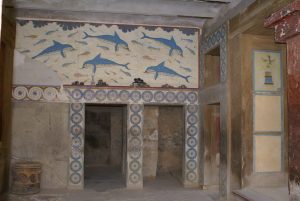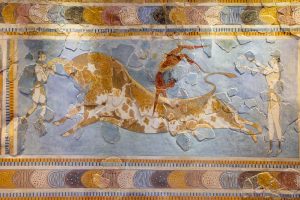Knossos Palace was a major Cretan Bronze Age settlement and one of the first western Palaces in history. This huge building left us with different architectural styles, diverse findings and hints about the Minoan society.

Image source: https://search.creativecommons.org/photos/6cab603e-1d60-45bf-9a95-da753fe60807
The architectural style(s):
What is still visible of the palace today is actually a mixed accumulation of features that have been added over time. Naturally, the latest periods left most of what our eyes can enjoy today and unfortunately what we can see now is not truly reminiscent of the original Minoan building. The reconstructions are based on an archeological evidence that helped experimental archeologists in making the today’s facsimile.

Image source: https://search.creativecommons.org/photos/453df24b-0dda-4b44-b24b-c9943965f7a9
Purpose of the complex:
The term “complex” is definitely more accurate than “palace” as the whole place contained different areas that served all kinds of purposes. It is archeologically obvious that the building was never the residence of a monarch. It wasn’t even intended as an acropolis-like area as the hill was never an acropolis in the Greek meaning of it as it wasn’t walled and in not very high ground. One of the reasons supporting the non-acropolis purpose of the area is that the Minoans were hardly a warlike population, concentrating on agriculture and sea trade instead. The palaces operated like local governmental, commercial, religious, and perhaps political hubs.

Image source: http://www2.edu.lascuola.it/edizioni-digitali/GuidaStudioStoria/solo-online/vol1/immagini/15-cnosso/index.html#/
The frescoes:
The first frescoes in Crete were kind of limited: monochromatic walls painted in either red or black, done with natural pigments. As we said earlier, the most probable nature of the Minoan people was commercial: this clearly is a link to cultures of the Eastern Mediterranean Sea such as the Egyptian and Near Eastern ones. The advent of monumental structures and frescoes used in floors, beams and walls have a high chance to be coming from that cultural exchange.
The first representations depict abstract shapes and more or less complex geometric designs; later on, subjects will be various (animals, objects, people) and of all kinds of dimension.

Image source: https://search.creativecommons.org/photos/2ef766ff-89ab-4b41-a81b-2a0656ccecd3
The Minoan Society:
Established the Minoans were mainly a non-military based civilization and a very ancient one with few archaeological intact proofs, outlining and knowing this society is a pretty hard task. These complexes were few as they were pretty elitist and big buildings and had diverse purposes. Thanks to the findings, the frescoes, the pottery, the jewelry and the remaining architectures we got to know some of their uses and costumes and society features. We understand that the Minoan people was confidently more complex than we imagine with all the characteristics that distinguished most ancient societies: a strong religious aspect into people’s lives, a strong central power and an agriculture-trading based economy.

Image source: https://www.flickr.com/photos/garrettziegler/26529276230/in/photostream/
Info source:
https://www.ancient.eu/Minoan_Civilization/
https://en.wikipedia.org/wiki/Knossos
